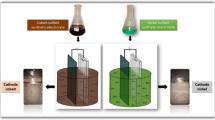Abstract
Physicochemical properties of copper electrolytes are a strong fundamental consideration in electrodeposition processes during electro-purification and recovery of copper. Their influence extends to mass transfer as well as energy consumption during the electrodeposition process. In this study, the influence of electrolyte composition on electrolyte physicochemical properties was investigated to review the existing literature data. This review of data is considered necessary as more and more electrowinning models are being developed for process prediction and optimisation and a need of such data is required for accurate prediction of physicochemical properties. The major components of importance to the formation of smooth high-quality and high-purity copper cathodes at optimum current efficiency are considered the species in solution. These include Cu ions, Fe ions (major impurity), H2SO4, and a smoothing agent additive. A 5-factor, 2- and 3-level experimental design was employed to determine the effect of copper (35 and 45 g/l), sulphuric acid (160 and 180 g/l), iron (1, 3, and 6 g/l), polyacrylamide additive (2, 5, and 10 mg/l), and temperature (45 and 55 °C) on electrolyte density, conductivity, and the diffusion coefficient in synthetic copper electrowinning electrolytes. The major species in a copper electrowinning electrolyte are found to be the most relevant for prediction of physicochemical properties. These results indicate that relatively simple empirical models are sufficient for modelling of the electrolyte domain in electrowinning, without the need for the generation of vast amounts of complex experimental data.










Similar content being viewed by others
Data availability
The data can be made available on request
References
Moats M, Khouraibchia Y (2009) Effective diffusivity of ferric ions and current efficiency in stagnant synthetic copper electrowinning solutions. Min Metall Explor 26(4):179–186. https://doi.org/10.1007/BF03402537
Moats MS, Hiskey JB, Collins DW (2000) The effect of copper, acid, and temperature on the diffusion coefficient of cupric ions in simulated electrorefining electrolytes. Hydrometallurgy 56(3):255–268. https://doi.org/10.1016/S0304-386X(00)00070-0
Panda B, Das SC (2001) Electrowinning of copper from sulfate electrolyte in presence of sulfurous acid. Hydrometallurgy 59(1):55–67. https://doi.org/10.1016/S0304-386X(00)00140-7
Price DC, Davenport WG (1980) Densities, electrical conductivities and viscosities of CuSO4/H2SO4 solutions in the range of modern electrorefining and electrowinning electrolytes. Metall Trans B 11(1):159–163. https://doi.org/10.1007/BF02657185
Price DC, Davenport WG (1981) Physico-chemical properties of copper electrorefining and electrowinning electrolytes. Metall Trans B 12(4):639–643. https://doi.org/10.1007/BF02654131
Subbaiah T, Das SC (1989) Physico-chemical properties of copper electrolytes. Metall Mater Trans B 20(3):375–380. https://doi.org/10.1007/BF02696989
Subbaiah T, Das SC (1994) Effect of some common impurities on mass transfer coefficient and deposit quality during copper electrowinning. Hydrometallurgy 36(3):271–283. https://doi.org/10.1016/0304-386X(94)90026-4
Baur JE (2007) Diffusion coefficients. In: Handbook of Electrochemistry. Elsevier, pp 829–848. https://doi.org/10.1016/B978-044451958-0.50036-7
Werner JM, Zeng W, Free ML, Zhang Z, Cho J (2018) Modeling and validation of local electrowinning electrode current density using two phase flow and Nernst-Planck equations. J Electrochem Soc 165:E190–E207
Araneda-Hernández E, Vergara-Gutierrez F, Pagliero-Neira A (2014) Effect of additives on diffusion coefficient for cupric ions and kinematics viscosity in CuSO4-H2SO4 solution at 60°C. Dyna 81(188):209–215. https://doi.org/10.15446/dyna.v81n188.41815
Gladysz O, Los P, Krzyzak E (2007) Influence of concentrations of copper, levelling agents and temperature on the diffusion coefficient of cupric ions in industrial electro-refining electrolytes. J Appl Electrochem 37(10):1093–1097. https://doi.org/10.1007/s10800-007-9363-8
Vereecken J, Winand R (1976) Influence of polyacrylamides on the quality of copper deposits from acidic copper sulfate solutions. Surf Technol 4(3):227–235. https://doi.org/10.1016/0376-4583(76)90035-2
Saban MD, Scott JD, Cassidy RM (1992) Collagen proteins in electrorefining: rate constants for glue hydrolysis and effects of molar mass on glue activity. Metall Trans B 23(2):125–133. https://doi.org/10.1007/BF02651848
Brown GM, Hope GA (1995) SERS study of the adsorption of gelatin at a copper electrode in sulfuric acid solution. J Electroanal Chem 397:293–300. https://doi.org/10.1016/0022-0728(95)04159-3
Coetzee C (2018) Characterizing the role of polyacrylamide additives in copper electrowinning (Masters dissertation, Stellenbosch: Stellenbosch University)
Robinson TG, Sole KC, Sandoval S, Siegmund A, Davenport WG, Moats M (2013) “Copper Electrowinning: 2013World Tankhouse Operating Data,” Proceeding of Copper 2013 Conference Vol. V Electrowinning/Electrorefining, Santiago, Chile: IIMCh, pp. 3-14
Quickenden TI, Jiang X (1984) The diffusion coefficient of copper sulphate in aqueous solution. Electrochim Acta 29(6):693–700. https://doi.org/10.1016/0013-4686(84)80002-X
Quickenden TI, Xu Q (1996) Toward a reliable value for the diffusion coefficient of cupric ion in aqueous solution. J Electrochem Soc 143(4):1248–1253. https://doi.org/10.1149/1.1836624
Montgomery DC, Peck EA and Vining GG (2012) Introduction to linear regression analysis (Vol. 821). John Wiley & Sons
Fogel’son RL, Likhachev ER (2009) Temperature dependence of liquid volume. Tech Phys 54(7):1082–1084. https://doi.org/10.1134/S1063784209070299
Kalliomaki T, Aji AT, Rintala L, Aromaa J, Lundstrom M (2017) Models for viscosity and density of copper electrorefining electrolytes. Physicochem Probl Miner Process 53(2):1023–1037. https://doi.org/10.5277/ppmp170227
Bousfield WR, Lowry TM (1903) Influence of temperature on the conductivity of electrolytic solutions. Proc R Soc Lond 71:42–54. https://doi.org/10.1098/rspl.1902.0059
Barron JJ, Ashton C (2005) The effect of temperature on conductivity measurement. TSP. 7(3):1–5
Kalliomäki T, Aromaa J, Lundström M (2016) Modeling the effect of composition and temperature on the conductivity of synthetic copper electrorefining electrolyte. Minerals 6(3):59. https://doi.org/10.3390/min6030059
Kalliomäki T, Wilson BP, Aromaa J, Lundström M (2019) Diffusion coefficient of cupric ion in a copper electrorefining electrolyte containing nickel and arsenic. Miner Eng 134:381–389. https://doi.org/10.1016/j.mineng.2019.02.027
Funding
The authors would like to acknowledge the funding support of the Wilhelm Frank Trust in this work.
Author information
Authors and Affiliations
Contributions
Mr. Chalwe Chibwe conducted research, analysed data, wrote the manuscript. Dr. Margreth Tadie: conceptualised, supervised, analysed data, and wrote the manuscript.
Corresponding author
Ethics declarations
Conflicts of Interest
The authors declare that they have no conflicts of interest.
Additional information
Publisher’s Note
Springer Nature remains neutral with regard to jurisdictional claims in published maps and institutional affiliations.
Rights and permissions
About this article
Cite this article
Chibwe, C., Tadie, M. An Experimental Review of the Physicochemical Properties of Copper Electrowinning Electrolytes. Mining, Metallurgy & Exploration 38, 1225–1237 (2021). https://doi.org/10.1007/s42461-021-00401-2
Received:
Accepted:
Published:
Issue Date:
DOI: https://doi.org/10.1007/s42461-021-00401-2




